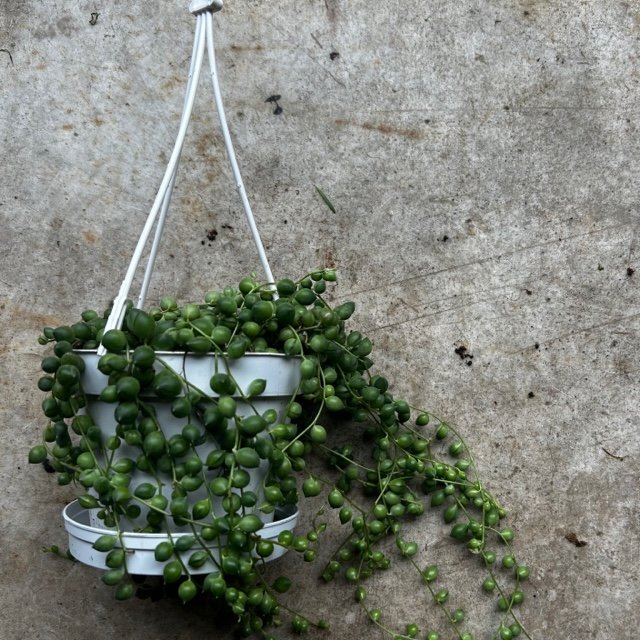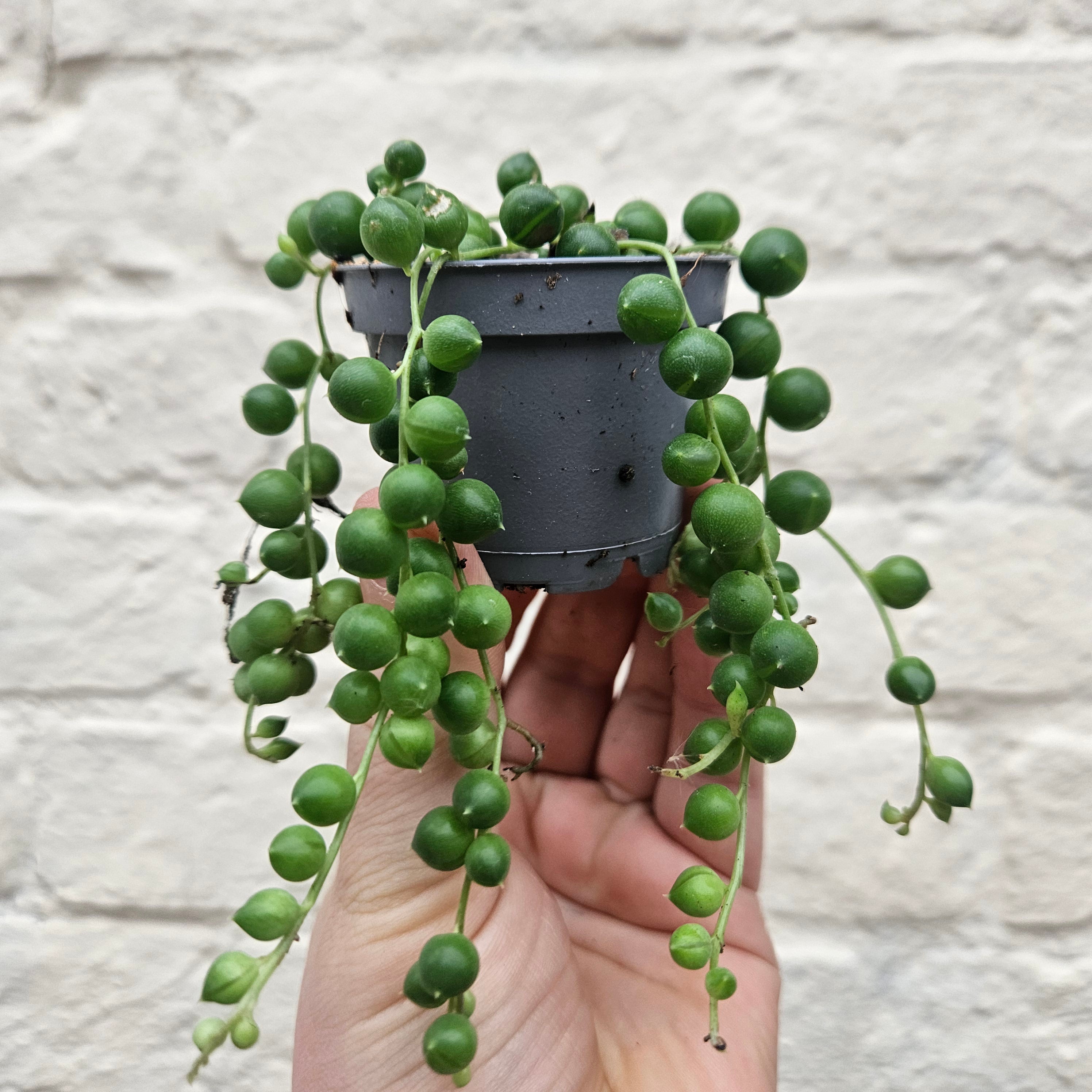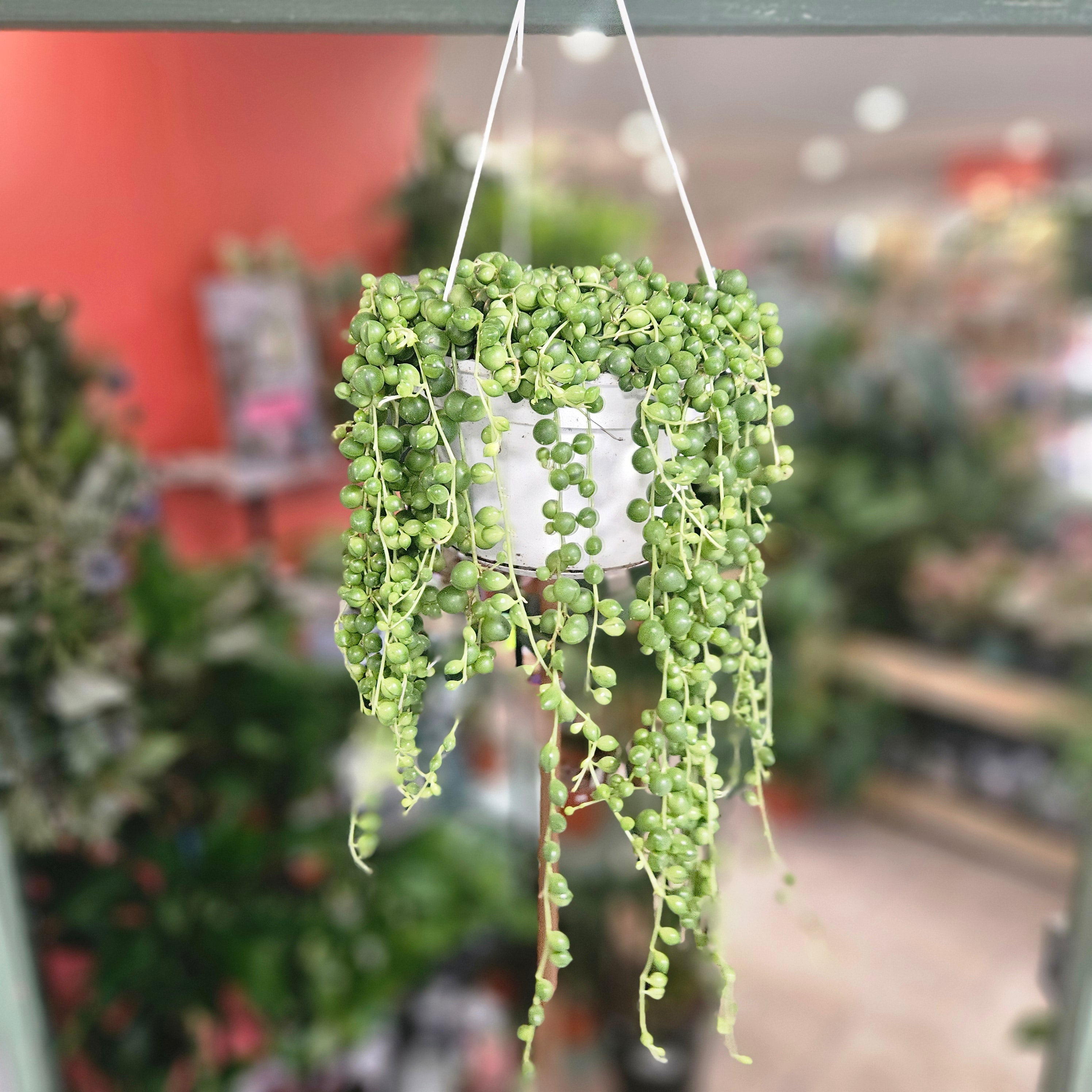Welcome to the wonderful world of Curio rowleyanus care, formerly known as Senecio rowleyanus! They are often referred to by their common name, String of Beads. This stunning and popular houseplant is known for its easily recognisable, pea-shaped leaves that hang delicately over the edge of the pot.
In this comprehensive guide, we'll walk you through everything you need to know to keep your Curio rowleyanus healthy and thriving.
Curio rowleyanus Overview
String of beads are native to dry areas of South Africa. In its native habitat, it creeps along the ground under bushes and rocks rather than trailing down. This unique succulent plant has small spherical leaves that grow from thin stems that cascade down making it a popular choice for hanging baskets.
The round shape is important as this minimises the area exposed, in turn reducing water loss. However, this can reduce the area where photosynthesis can happen. If you look closely each bead has a small darker translucent stripe, this is called an ‘epidermal window’. This allows more photosynthesis to occur as it lets more light enter the leaf.
String of Beads is favoured by houseplant enthusiasts due to its interesting and unique look - if you're a fan of something a little different, check out our regularly updated range of unique houseplants.

How to Look After a Curio rowleyanus (String of Beads)
Light:
String of Beads thrive in bright, indirect sunlight making sure the sun is reaching the top of the plant. Avoid direct sunlight as it can scorch their leaves, especially in the midday sun. String of Beads will tolerate some direct sunlight during the early morning and late evening when the sun rays are less harsh.
Temperature and Humidity:
Maintain a temperature of around 10°c or above in winter and 22°c and above in spring and summer. These plants don't like humidity so avoid placing them in areas such as a kitchen or bathroom where humidity levels are higher!
Watering:
Careful watering of String of Beads is essential. They are native to arid regions so water when the soil is completely dry. Avoiding overwatering is important to not cause root rot. The best way to test if it needs watering is to stick your finger in the soil to test moisture levels.
Another way to tell is to wait till the pearls look dull and about to shrink/shrivel due to lack of water. It is also our recommendation to water String of Beads from the bottom to avoid getting the leaves wet which can cause them to rot.
Fertilising:
During the growing season (spring and summer), feed your String of Beads with a balanced liquid fertiliser every 2 to 4 waters, and dilute to half the recommended strength. Stop feeding in the dormant winter months.
How to Re-pot a String of Beads
Re-pot your String of Beads when it becomes root-bound or outgrows its current pot, typically every 1-2 years. Choose a pot that's one size larger with drainage holes, providing fresh soil ideally a cactus type of soil that is free draining. Gently transfer your plant, being careful not to damage the roots.
How to Propagate a String of Beads
Propagating a String of Beads is an exciting way to grow new plants, Ideally done in spring or summer. Follow these steps:
Stem cutting
- You will need clean shears, pot and cactus soil mix.
- Choose a Healthy Stem: Select a stem that is at least 3-4 inches long, that has at least 3/4 sets of leaves and cut.
- Leave these out for a day or two to allow the ends to callous over.
- Fill a pot with your soil and in the centre make a hole. Insert the cut end in and gently press the soil around the stem. All leaves should be above the soil. Coil the rest around the top - where the stem is touching the soil a root should form.
- Place the pot in a spot that receives bright but no direct sunlight and wait a few days before watering. Water when the soil feels dry.
- After a few weeks, you should see the cuttings have rooted.
How to Prune a String of Beads
Pruning your String of Beads helps maintain its shape and encourages healthy growth. Trim any dead pearls and stems as well as leggy stems. This will help promote bushier growth.
How to Take a Cutting from a String of Beads
Taking cuttings for propagation follows a similar process as mentioned earlier. Ensure you choose a healthy stem, make a clean cut, and follow the propagation steps.
How Often Should I Water a String of Beads?
Watering frequency depends on various factors like temperature, location and pot size. If in a shadier spot, it will need less watering than one in a brighter location. As a general rule, check the soil and water when it's completely dry. Water less in winter and more frequently during the growing season.
Why Are My String of Beads Leaves Going Yellow/Brown/Shriveling
- Yellow Leaves: Yellowing leaves can result from overwatering, poor drainage,or pests. Adjust your watering, If the leaves are wilting and yellowing it is most likely to be due to overwatering, check the roots for rot and re-pot if necessary. Sometimes yellow leaves can just be old leaves, take these off carefully. If you notice signs of pests you should treat them with a pesticide.
- Brown Leaves: Brown edges or spots may indicate overwatering or direct sunlight. Adjust your watering routine and placement.
- Shriveling Leaves: Curling leaves can be a sign of underwatering or over-watering. Ensure proper watering and adjust the frequency of watering.
How to Make a String of Beads Bushy
Encourage bushier growth by regularly pruning leggy stems. Ensure your String of Beads has enough light, lack of light can cause this plant to become leggy.
Are String of Beads Poisonous to Cats and Dogs?
Yes, Curio rowleyanus is considered toxic to cats and dogs. It can cause oral irritation, drooling, and digestive issues if ingested. Keep your String of Beads out of reach of pets or opt for pet-friendly houseplants.
With these expert tips, you're well-equipped to care for your Curio rowleyanus and enjoy its lush, tropical beauty in your home. Buy a new String of Beads and happy growing!
































